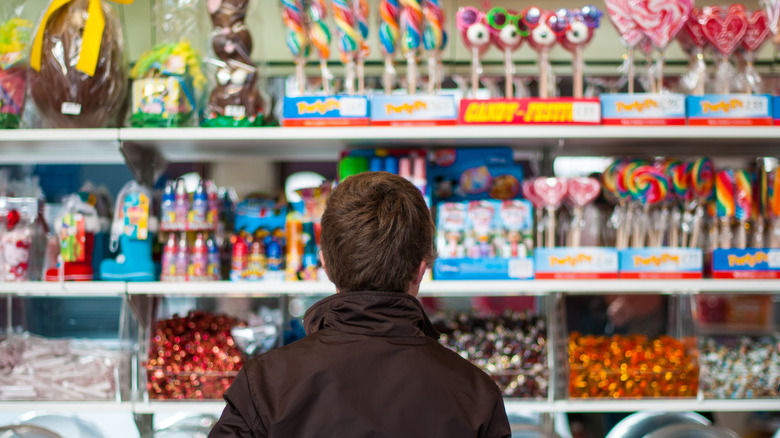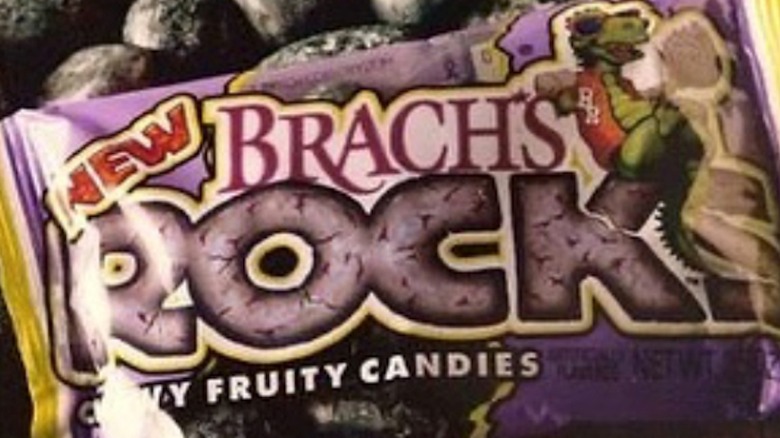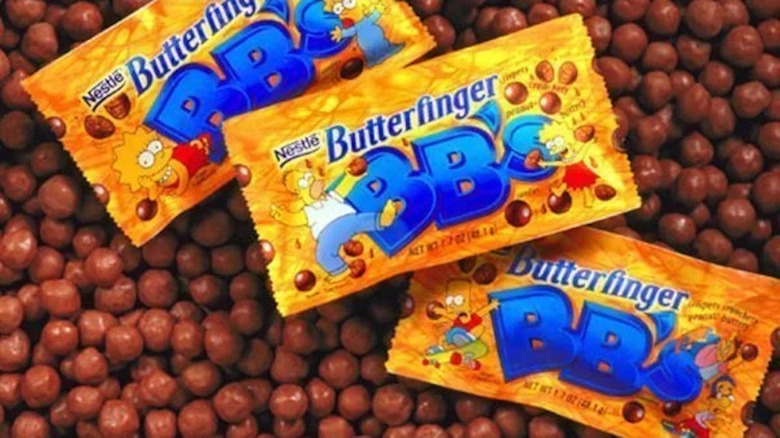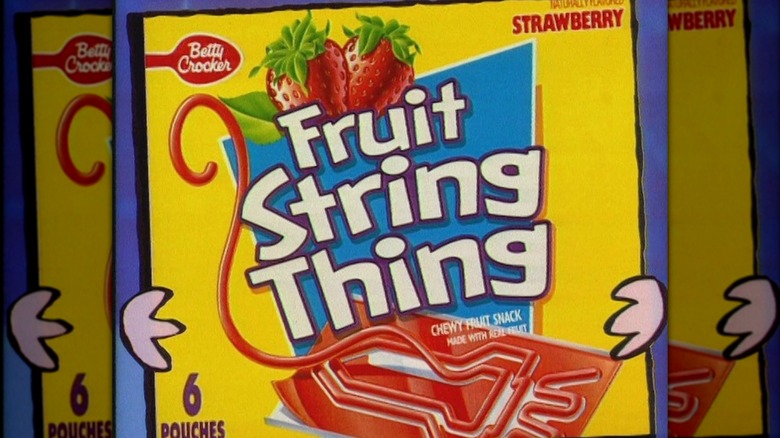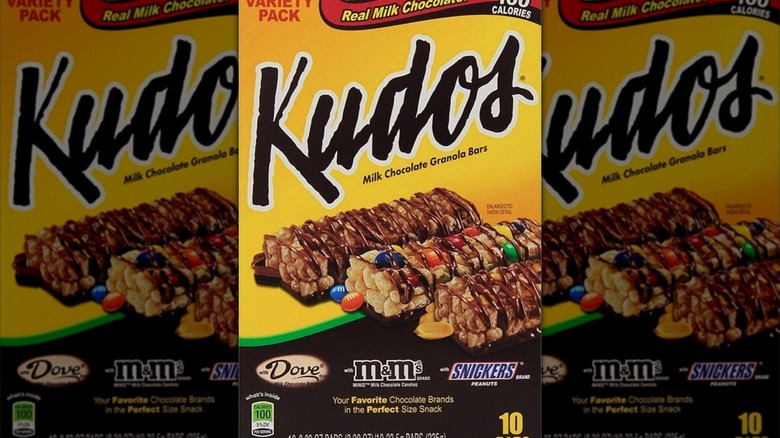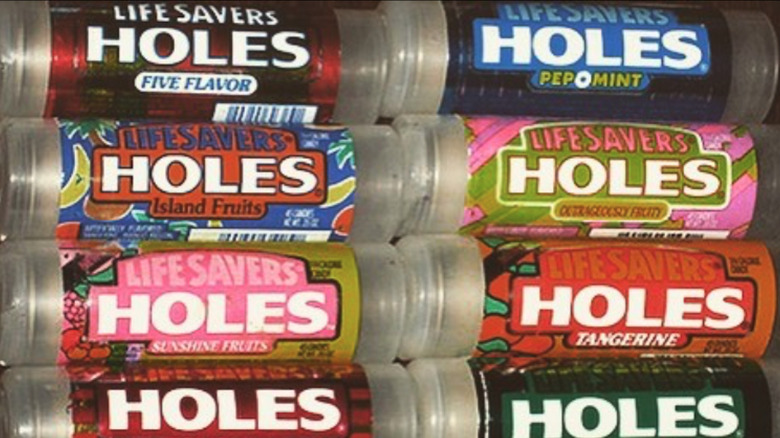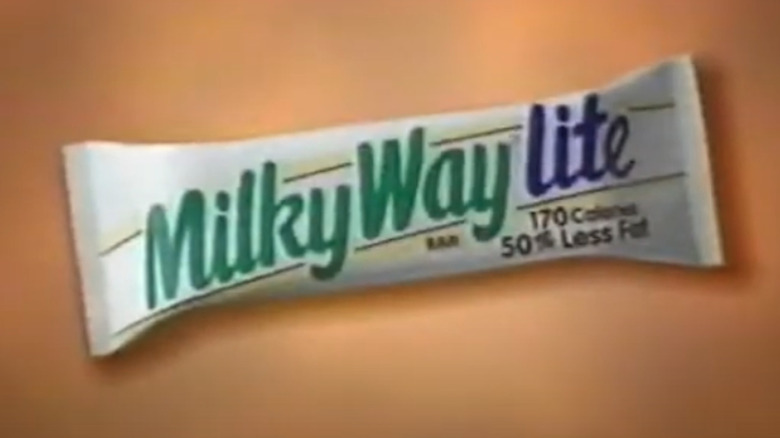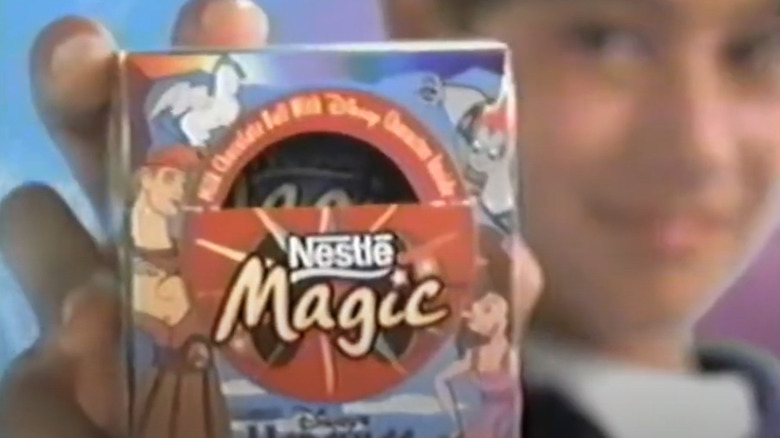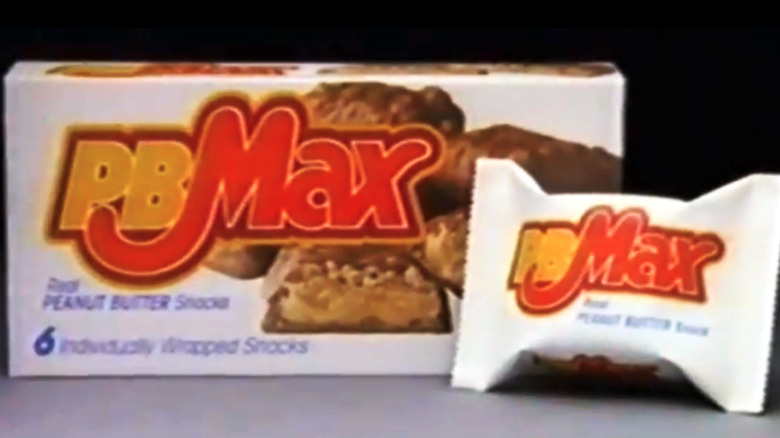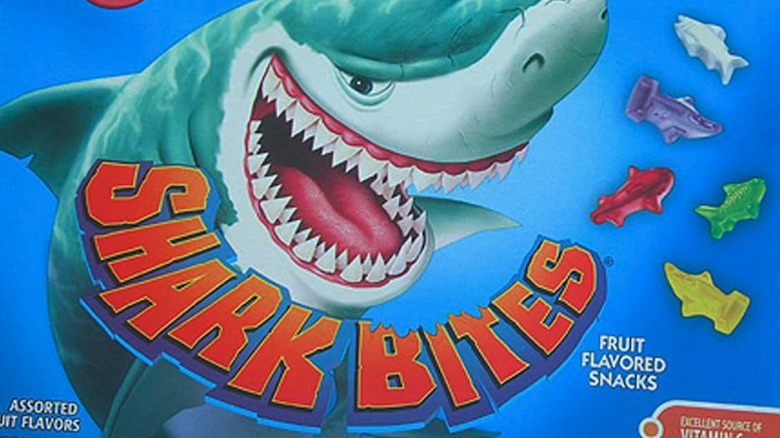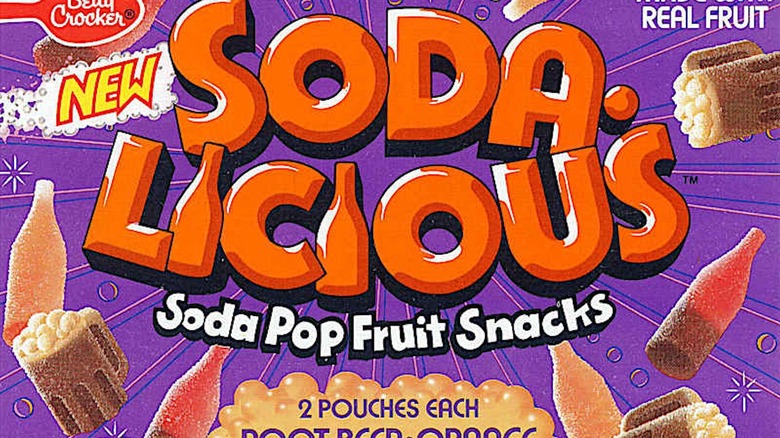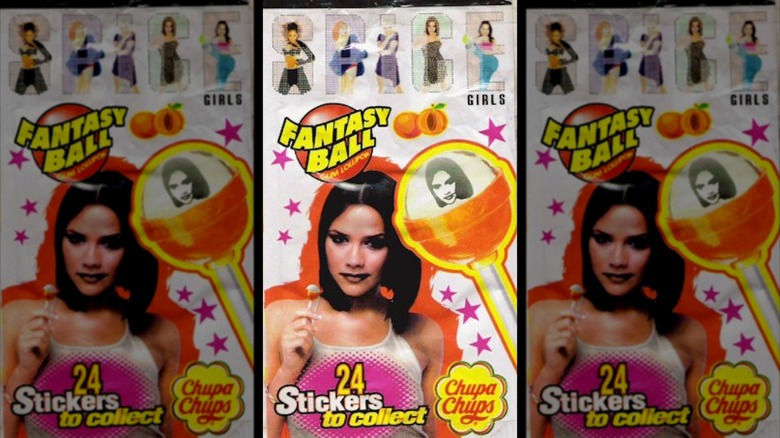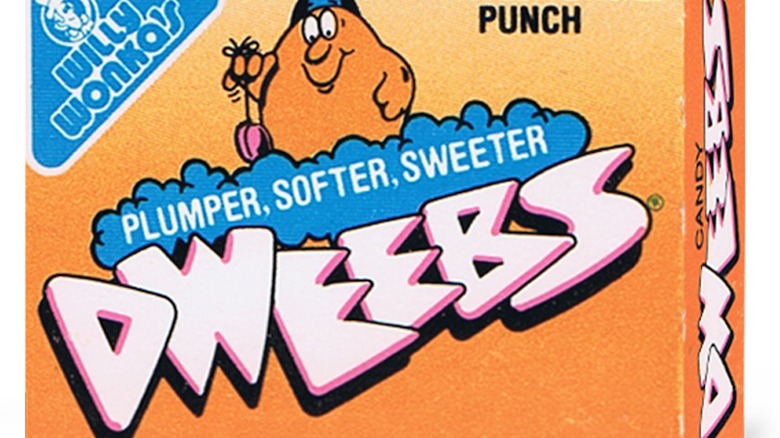Old-School Candy From The '90s That Need To Make A Comeback
We may receive a commission on purchases made from links.
Sometimes, all it takes is a turn of phrase reminiscent of a slogan you haven't heard in decades to send you on a trip down memory lane. Where food is concerned, studies have shown a direct correlation likely exists between a flavorful memory and the time and place in which it was initially enjoyed. The trouble is, after recounting the glory days of inline skates and the dance craze that was the Macarena, some cravings to relive the 1990s are sadly no longer capable to be satisfied.
Whether this millennium-capping decade was when you experienced your formative years or when you watched your own kids delight in childhood, there are plenty of candies as indicative of the age as Tamagotchis and Super Soakers. If the '90s were before your time, you may not yet understand all the fuss about getting the best flavored gummy in the pack or what particular kind of Butterfinger Bart Simpson refused to let his family lay a finger on. While certain treats may have left the market long ago, the hope to taste them once again remains and each one of these discontinued delights is sure to send some back to summer camps, lunchrooms, or schoolyards swapping trading cards for fruit snacks.
Brach's Rocks
At the start of 1993, Whitney Houston's "I Will Always Love You" was still riding the top of the charts after the box office success of her film "The Bodyguard." But kids with access to cable television were more likely interested in their favorite shows on the Disney Channel and Nickelodeon. It was there that they would have been introduced to Rocky D., the letterman jacket-wearing dinosaur pitching rock candy-coated chewy treats in five fruit flavors that included cherry, grape, lemon, orange, and strawberry.
Looking every bit like geodes when cracked open, the packets of jelly rock candies were also advertised in trade publications meant to coax retailers into carrying the treats. These days, the Brach's candy company promotes a limited assortment of traditional year-round candies like caramels and peppermints while offering special treats at the holidays such as St. Valentine's Day hearts with messages and the Halloween favorite with fancy flavors, candy corn. Seeing as they still sell jelly beans, those who long for a return of the limited run candy of the early '90s can hold out hope that one day the "dinosaur extraordinaire" may return from extinction to bring this fossilized treat to a new generation.
Butterfinger BBs
Stretching back to the late '80s, fans of "The Simpsons" readily associate Homer Simpson with doughnuts. Where his skateboarding son Bart is concerned, Butterfingers are what's worth having a cow over. While the original candy bar dates back to the 1920s, in 1992 then-owners Nestlé released the marble-like offering of Butterfinger BBs that they continued selling until 2006. In keeping with the slogan that "Nobody better lay a finger" on the treats, Bart was often shown having no qualms eating an entire pack of the coated, crispy, peanut butter candy.
In fact, when he wasn't having nightmares about the denizens of Springfield chowing down on his stash of chocolatey goods, the routine troublemaker was tormenting his own dad by keeping the treats just out of reach. Now owned by the Ferrara Candy Company, Butterfinger continues to market with "The Simpsons," but has long since left BBs in the past. Now the line-up of bite-size offerings includes Butterfinger Fun Size, Butterfinger Minis, and Butterfinger Bits that can be used to sprinkle on ice cream or baked goods. Upon acquiring Butterfinger, Ferrara explained the move to improve the recipe and update the packaging for freshness of the now century-old candy that left many counting the bars among foods that don't taste they way they used to.
Fruit String Thing
Undermining efforts at instilling proper behavior to youth everywhere, Betty Crocker ventured away from its cake rivalry with Duncan Hines and turned cries to not play with food on their head with a product that intended for kids to do exactly that. Much to the chagrin of parents, the General Mills-owned brand brought Fruit String Thing to market in 1994. As children caught on to the craze with animated advertisements that promoted imaginative expressionism, moms and dads could at least justify their purchase of the snacks served up on a card stock backer thanks to the packaging touting the real fruit used in doling out some vitamin C.
In addition to commercials, Betty Crocker found a marketing partner in one of the most popular book series of all time. Dominating school book fairs for years before anyone had ever heard of Harry Potter, R. L. Stine's "Goosebumps" spawned spin-off series', television shows, and movies. Through General Mills Box Tops promotion, proof of enough purchases of the products made kids eligible to receive a book. Stine also advertised his Brain Juice title contest on packages, giving fans a chance to have their title suggestion used in a future publication of the series along with a visit from the author to their school. The lasting endurance of "Goosebumps" did not carry over for Fruit String Thing as the snack's popularity fizzled out early in the next decade.
Kudos
As ubiquitous as a late-night Tony Little infomercial marketing the Gazelle to those looking to get in shape or stay in shape, efforts to appeal to the health conscious were everywhere in the 90s. For those who didn't want to hop onto the next juice fad or simply didn't have the cash to splurge on a brand new piece of exercise equipment, Mars Inc. had introduced a more decadent alternative to the traditional granola bar to satisfy the sweet tooth of dieters. Initially launched in 1986, but the time the '90s were underway the health-focused granola bar was being sold in seven flavors.
Over the course of its evolution, Kudos had shifted from something of a healthy candy bar to more of a chocolatey granola bar with the intention of being a substitute for a more traditional tasty treat. In time, Mars began to incorporate some of its other brands into marketing the bars as Dove, M&M's, and Snickers were added to different varieties of the snack to ramp up the candy appeal. Meanwhile, Simply Kudos had been introduced in 1993 as a lower calorie alternative that took away the chocolate coating. Though long-lived, by 2017 the bars were no longer available.
Life Savers Holes
Attempts to make old things new again saw some major successes along with some disastrous failures in the '90s. While TGIF programming harkened back to the Friday night lineups of the past thanks to the roaring success of sitcoms like "Family Matters" and "Step by Step," a twist on Life Savers resulted in a quick recall over choking hazards. Akin to the holes of doughnuts, Life Savers Holes were introduced late in 1990 nearly 80 years after the original candy was invented.
Unlike the mainstay of checkout lines across the country, Life Savers Holes were pulled from store shelves in January 1991 as the packaging had parents complaining of the choking risk to kids who saw fit to remove the tubes' caps by biting them off and inadvertently swallowing them. Though a package redesign brought them back on the market within months, the market appeared to have little appetite for a second chance on the holes that were ultimately discontinued, and consumers instead gravitated toward the release of Life Savers Gummies which remain available to this day.
Milky Way Lite
Accompanied by the sultry tones of a saxophone during the same era that President Bill Clinton was wowing the MTV generation and fans of Arsenio Hall with his jazzy stylings, Mars Inc. sought another inroad into American dieters with a twist on a popular candy bar. Introduced in 1996, Milky Way Lite became the first low calorie candy bar to attain the specifications necessary to include the "lite" label on its packaging. Like the strict rules under the Food and Drug Administration's to brand a product "healthy," the FDA set criteria for qualifiers.
In cutting 50 calories off of its regular candy bar and slashing the fat content in half, Mars had opted for the synthetic sugar polydextrose that only has one calorie per gram compared to the typical ingredients which had four calories. Additionally, the carbohydrate is indigestible for humans and promotes the growth of good bacteria within the digestive system. However, too much of it results in a laxative effect. While commercials contended, "Bet you can't tell it's a lite," and consumers tended to agree, the interest in the low-fat alternative to Milky Way died off before panic over the Y2K bug could reach its peak.
Nestlé Magic Ball
In the mid-'90s, Nestlé released a product that took the zeal that kids have for sweet treats and coupled it with the excitement of a prize-packed Cracker Jack or cereal box, and introduced the world to the Nestlé Magic Ball. These milk chocolate spheres were then given a marketing supercharge when the manufacturer partnered with some of the hottest character brands of the decade to offer small figurines inside each ball. Unfortunately, the same enthusiasm that set kids on fire for Pokémon, SpongeBob SquarePants, and their favorite Cartoon Network characters had parents worried about little ones being too eager to take a bite out of the Magic Ball before extricating their prize.
As a result, the Magic Ball was pulled from store shelves in 1997 only to later return by 2000 under the new name, Wonder Ball. Instead of a toy, these treats were sold with candies as well as stickers inside with some of the same characters — like Pikachu and the Minions from "Despicable Me" — gracing the packages. Still, the fanfare for Wonder Balls was nearly as short-lived as their predecessor as The Frankford Company took possession of the candy-filled chocolate spheres in 2004 only to decide to discontinue their production shortly thereafter.
PB Max
While the world was between 007s, a candy bar combining peanut butter, chocolate, and cookie pieces had its rise and fall before Pierce Brosnan could say, "Bond, James Bond." The same year that Timothy Dalton had his second stint as the British secret agent, Mars Inc. launched the PB Max and, decades later, fans are still craving its return. Leaning into the abbreviated title for its marketing, PB Max commercials served up a surreal tableau of incorrect meanings: parachuting buffalo, pineapple beanies, pig basketball, and a prehistoric barber.
Making it clear that the PB stood for the peanut butter-covered cookie wrapped in chocolate, Mars showcased the crunchy contents before closing out the 30-second spot. As it happened, the same enthusiasm that saw fans of the candy launching social media campaigns in hopes to see its return to the market was not shared by the family behind the brand. In the book "The Emperors of Chocolate: Inside the Secret World of Hershey and Mars," former Mars executive Alfred Poe credited the 1994 end of PB Max's run to the Mars family's own aversion to peanut butter. While the candy had brought the company $50 million in sales, their taste had the final word.
Shark Bites
Just as Shark Week had premiered in 1988 capturing the terrifying mystery of the sea creatures, made all the more frightening by Steven Spielberg's "Jaws," the satisfying Shark Bites Fruit Snacks had first graced store shelves the same year. Like other shark themed ventures of the '90s — including the NHL's San Jose Sharks and the cartoon show "Street Sharks" — the gummy snacks were a hit, especially because of the inclusion of special pieces.
Of the fruit snacks found in lunchboxes across America, special pieces began to debut that went a long way in cafeteria trades. Among the prized treats were the all white version of the great white shark, the cream-colored offering of shark teeth, and the orange-striped tiger shark. Originally part of the Fruit Corners brand under General Mills that was also responsible for the wildly popular Fruit Roll-ups, Shark Bites had attempted a resurgence under Betty Crocker. As it was, changes to the recipe had impacted all the touchstones of nostalgia, depriving the treats of their memorable appearance as well as the taste in texture and flavor. Though their return was short-lived and is no longer represented under Betty Crocker's fruit snack stable that instead boasted Disney, Marvel, and other popular characters, diehards could try their hand at making homemade gummies with only four ingredients.
Sodalicious Soda Pop Fruit Snacks
Whether or not drinking soda was commonplace or a rarity, kids in the early '90s shook up their imaginations and let the foam fly when they bit into one of Betty Crocker's Sodalicious Soda Pop Fruit Snacks. The snacks shaped like bottles and overflowing mugs came in cherry cola, orange, and — no doubt popular in Utah — root beer flavors as well as grape, lemon lime, and red punch. In addition to the color coordinated flavors, the gummy snacks had a sugary coating that offered up a sensation similar to the fizz experienced when enjoying a cold swig of soda.
Betty Crocker took their marketing to the next level with the treats by serving up scratch and sniff stickers in the boxes – like a skateboarding cherry and a sunglass wearing bunch of grapes – and the character designs represented each of the flavors. A year after their launch, the popularity expanded with a 7Up partnership that found mascot Spot — who had his own video "Cool Spot" video game in 1993 — delivering both regular and Cherry 7Up flavors. Despite fanfare, the fruitier flavors were taken off the market by 1995 with the remaining Sodalicious treats lasting only until 1998.
Spice Girls Chupa Chups Lollipops
Riding the wave of success of New Kids on the Block, the '90s had no shortage of boy bands making young girls swoon across the country and overseas on both television and radio stations. While fandoms feuded over Backstreet Boys and NSYNC, a new British Invasion took the states by storm with "girl power" promoting Spice Girls. By far the best-selling girl group of all time, the ladies of London didn't just top the charts, they also took over all corners of popular culture — including having their faces plastered on a line of candy.
The Chupa Chups tie-in with the pop sensations hardly had the staying power the entertainers had and now the lollipops, crazy dips, and bubble gum that featured the "Wannabe" vocalists are considered collectors items. Compared to the original advertised price at 20 cents a piece, the lollipops that came with a sticker can now be found advertised for 100 times that amount on digital auction sites. As the special edition line of Chupa Chups candy had been released around the same time as the Spice Girls had hit theaters with their musical comedy "Spice World," talk of members of the quintet getting back together for a reunion tour in 2026 would prove an ample opportunity to launch another promotion.
Willy Wonka's Dweebs
Timed for the release of the movie "Willy Wonka & the Chocolate Factory," an adaptation of Roald Dahl's famous book, the Sunmark Corporation began selling candy under the Willy Wonka Candy Company brand inspired by the story in the 1970s. Initially offering Wonka Bars and Everlasting Gobstoppers, by the '80s the company introduced the crunchy little flavor-packed candy Nerds that came boxed in divided pairs like grape and strawberry. When the '90s rolled around, the happy little cartoon creatures that represented Nerds welcomed a bigger cousin in Dweebs.
Sold in packs with three flavors instead of two, Dweebs were also less sour than their little cousins until alternative flavors were introduced. However, their time was short-lived in the American market as they were discontinued in the '90s. As for their smaller predecessor that lives on to this day, Nerds had made their way to the ownership of the Ferrara Candy Company — and the Nestlé-distributed candy comes in varieties such as Nerds Rope and Gummy Clusters.

